![]()
![]()
![]()
Use LEFT and RIGHT arrow keys to navigate between flashcards;
Use UP and DOWN arrow keys to flip the card;
H to show hint;
A reads text to speech;
85 Cards in this Set
- Front
- Back
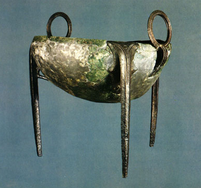
|
Olympia bronze tripods (early evidence of cult) •Circa 800 BC •Olympia •Originally winners of the olympic games would win bronze tripods as prizes. This later changed and was replaced with an olive wreath. When it talks about evidence of cult it means that this time people came together not through animal sacrifice not through meeting at altars BUT through ATHLETICS. (display of religion/cults through athletics)
|
|

|
Olympia sanctuary plan (with early race track) * Contained many temples and shrines along the race track and stadium. Not a city-state but was used as a panhellenic meeting place for athletic competition and worship every four years. Contained the temple of Zeus and Hera and a pelops cult where his grave was. |
|
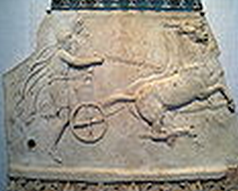
|
Olympia grave of Pelops •Circa 1000 BC •Pelops and Hippodamia: Chariot race against king to win princess but king has divine horses so Pelops sabotaged chariot and king curses him before he falls to his death -- Pelops had a massive cult following in olympia
|
|
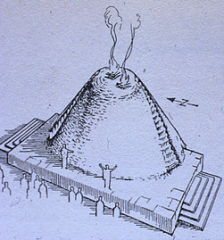
|
Olympia ash altar the focus of zeus’ cult- an enormous altar formed from the accumulated remains of sacrificial animals * we know about it from (~2nd century i think) descriptions from literary sources |
|
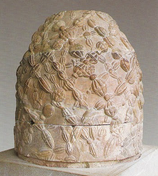
|
Delphi omphalos •Circa 1100 BC/date unknown •Delphi in North Greece •Mythologically this stone represents the stone that Kronos ate, saving Zeus's life. In actuality it may have been made and placed at the sight by later Roman tourists. •Means “bellybutton” in Greek, said to be bellybutton (center) of Earth |
|
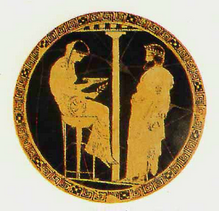
|
Pythian priestess •snake oracle women at Delphi •circa 800 BC -apollo made his pronouncements once a month via the pythian priestess, who then passed them on to official interpreters -apparently she sat in a giant tripod like the bronze ones at olympia -in order to ask Apollo something one had to make a good enough sacrifice and this was judged by the Pythian priestess -she answered your questions in gibberish, greek poetry, or just a riddle -people wrote down Qs on clay tablets & some have been found @ Delphi |
|
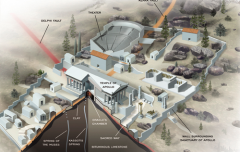
|
Delphi geological fault lines •gas possibly came from earth which could’ve caused priestesses visions |
|
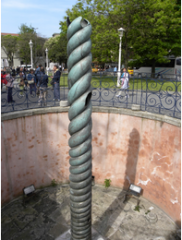
|
Delphi serpent column It was built to commemorate the Greeks who fought and defeated the Persian Empire at the Battle of Plataea |
|
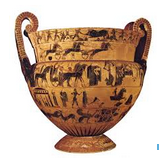
|
Francois Vase and its makers * Deals with Trojan war in different aspects |
|
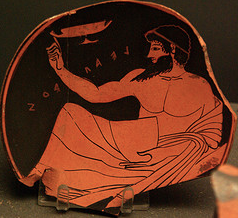
|
Symposium, Kottabos * kottabos: drinking game of balance and love. game of skill in which men would fling wine lees(yeast deposits, wtf?) at targets while uttering the names of the person of affection |
|
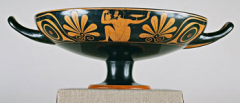
|
Eye cup (Kylix) * circa 6th century |
|
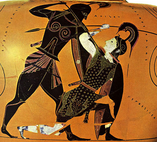
|
Exekias: Achilles vs. Amazon (Queen Penthesilea) * breaking boundaries there was no more “smiles” but now more elaborate and expressive scenes |
|
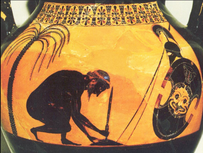
|
Exekias: suicide of Ajax * technique of scratching pot to reveal clay color underneath |
|

|
Andokides Painter: bilingual vases * Pioneers of this technique: Euphronius, Euthymides, and Phintias |
|
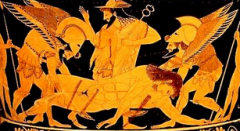
|
Euphronius Sarpedon crater (Athens?) * One of pioneers of Red Figure |
|
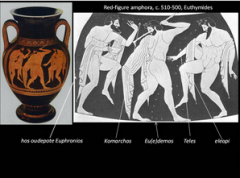
|
Note: Euphronius was an ancient greek vase painter; same as Euthymides
Euthymides “never before as Euphronius” * Using new techniques, artists are self-aware of each other |
|
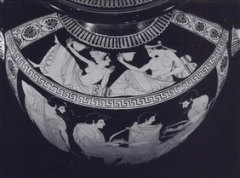
|
Phintias’ portrait of Euthymides and girl kottabos players * Linking him as an elite |
|

|
Kritios Boy kouros * last Kouros boy |
|

|
Blonde Boy kouros head * 480 bc |
|
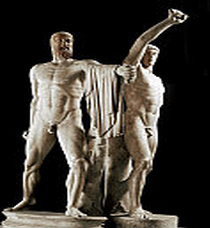
|
Tyrant slayers statue group, 477 B.C. * Showing critical moment of action of human body on pottery, show emotion through body |
|
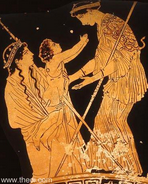
|
Autochthony and vase showing Earth holding baby Erechtheus * This is how the Athenians link themselves to Athena. |
|
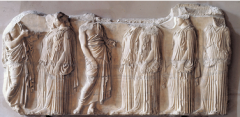
|
Panathenaic procession * 5th century B.C. |
|
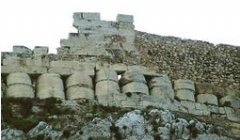
|
Pre-Parthenon column drums in Acropolis wall * sending message that they survived the persian attack, used pieces as trophies. They built the temple during 490 (before the 480 persian sack obvi) because they had just first fought the persians single handedly, which was the pre-cursor to the persian wars. they built the temple to celebrate, but then when the persians came in 480 they were mad and obliterated it |
|
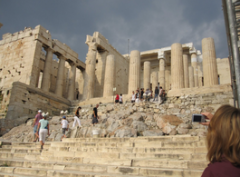
|
Propylaea * Wide ramp going up to fit more people, triglyphs |
|
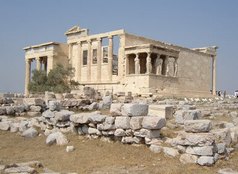
|
House of Erechtheus circa 420 BC cult of Athena Polias most important religious building first Athenian citizen Where main religion show took place; 10 diff cults in small building; this is where erechtheus is worshiped; where Poseidon gave his gift to Athenians, smashed trident down and salt water came up which was amazing; first olive tree given to Athenians here; has most unusual plan of any greek temple: side porch with maidens holding it up, another porch that has its own nexus of cults being generated- this is very asymmetrical; skylight and preserved where Poseidon touched Athens with his trident; statue of Athena taken from trojan war-dressed up in a robe each year, main cult statue taken out of temple each time to take a bath. This cult known as Athena polias. This is main temple of Athena. strongest structure because incorporates past which could have been moved but kept in place to signal religious continuity. Working out solutions to keep everything in place but updated |
|
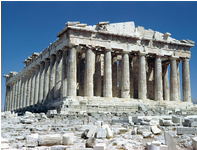
|
Parthenon plan * celebration of the wins over the Persians |
|

|
Parthenon metopes, pedimental sculpture, Panathenaic frieze, |
|

|
Panathenaic prize vase Vase depicting which category you win in Pictures an armed Athena on the front 560 - circa 300 BC (unkown) (verify please!) |
|
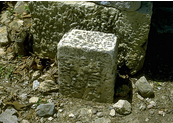
|
Athenian Agora horos boundary stones * Inscribed marble posts were used to mark the entrances to the Agora wherever a street led into the open square. Inscribed with "I am the boundary of the Agora.” The limits of the square had to be well marked for two reasons. First, people who were underage or who had been convicted of certain crimes were not allowed into the Agora, and markers were needed to define what was public land, to prevent encroachment by private buildings |
|
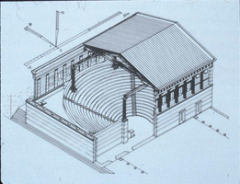
|
Note: bouleuterion is a building which housed the council of citizens (boule). prytaneion is a (greek) town hall.
Agora bouleuterion (place where boule meets) and prytaneion (place where prytaneis meet, a tholos or round building) * Need someone to be stationed at the Agora in case of war or if anything happened --> prytaneion represents the life and the heart of the city --> one tribe is on duty in that month in the Prytaneion and operated in a 10 month calendar --> the junk that they threw away were basically wine cups, drinking out of cups that weren't decorated and were cups of the people --> horrible preservation --> prytaneion is also called tholos and tholos means round building and there was only one round building |
|

|
Agora tribal heroes statue group * one statue for each of 10 tribes → shows the relevance of each tribe |
|

|
Agora royal stoa (circa 500 BC) * If people wanted to put people up for death, they would take them here and put them on trial |
|

|
Agora jury allotment machine * eliminated possibility of wealth swaying legal system |
|

|
Agora weights and measures * traders could be fined for ripping people off |
|
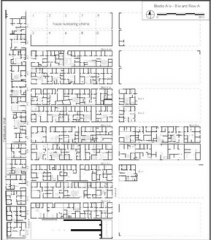
|
Olynthos, town planning * Strong democratic impulses |
|
|
Pastas House |
-porch faces the courtyard (facing South to avoid sun) -Andron is the symposium room (raised floor around the room for the couches) -weaving room for women (GENDER DIVIDE)
|
|
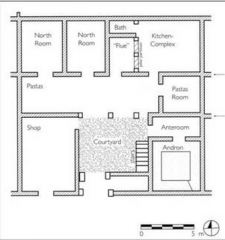
|
Olynthos, house plan * 60 ft by 60 ft |
|
|
Olynthos, symposium room, weaving places, shops |
* had little shops in the houses where sold specialized things. knew there were shops based on found coins, evidence of countertops, and doors only facing outside streets
|
|
|
Olynthos, house prices |
* stone in front of house that informs who the house was for originally, who it belongs to now, who it was sold by, and how much it sold for
|
|
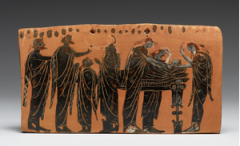
|
Funeral: 3 stages * Mourners not supposed to sleep or eat, and women pull on their hair; constantly grieving (mourning by hurting oneself)* having a meal at the tomb |
|
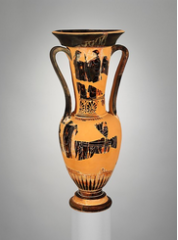
|
Loutrophoros (water wedding vase) in clay and as tomb stone * marraigable age=14 |
|
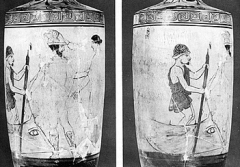
|
Hermes, Charon, and dead on white ground funeral perfume jars (PSYCHOPOMPOS) * Only 15% of people actually put charon’s fee in mouths of dead though so probably was not widely believed |
|

|
Kerameikos cemetery: plan, Archaic tumulus graves, tombstones * Mass burial 430-420BC; 150 bodies (massive plague) |
|
|
Pottery from Archaic offering trenches (feasting at tomb) |
* made whole class of pottery for funeral parties
|
|
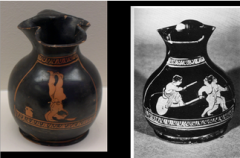
|
Children jugs (after 550-500) after 500 BC Can tell by tomb offerings they get if they’re young adolescents Tiny little wine jugs with scenes of kids doing stuff like playing, and pot includes drawing of the pot itself in the scene Can tell what most popular toy is in Athens based on these stories on pots If you die at 7, what really defines you is your participation in the ceremony of drinking wine |
|
|
Family grave stones (after 550-500) |
* nuclear family replaces the collective identity of the city-state
|
|
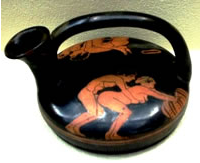
|
Keramikos building Z (brothel?) - 435 BC · Inside city walls · Lots of wine cups and things to pour wine. Looks very much like a commercial establishment · It’s a brothel bar · Using literary sources and reading into the imagery Pictures and symbolism of Aphrodite (goddess of smex?) |
|
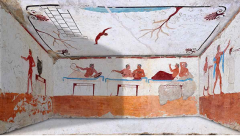
|
Tomb of the Diver, Paestum (symposium death scene) * walls decorated to show that they are in an everlasting symposium or maybe to exemplify that they were men and these were characteristics of manhood |
|
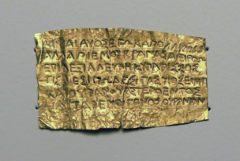
|
Orpheus and Orphic tablets -Orpheus is the main figure. these tablets were thin gold plates that had inscribed the secrets of the afterlife. -4th century found in the graves of followers of this practice. -these are associated with the myth of Orpheus going into the underworld to save his loved one. |
|
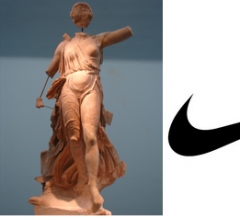
|
Nike of Paeonius at Olympia * Whimsical, has serious purpose but Nike is designed to be enjoyed as source of pleasure |
|
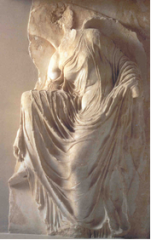
|
Nike fixing sandal on parapet of Athena Nike temple, Athenian Acropolis * Now a Nike is just adjusting her sandal, so we have reduced her to something less serious. View Nike as hot so she is something to look at and admire, looks like water thrown at her to show her body and breasts |
|
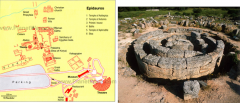
|
Note: Asklepios is the god of medicine
Sanctuary of Asklepios, Epidauros: plan, tholos, stoa for sleeping, |
|
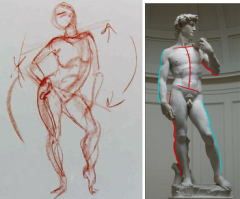
|
Contrapposto * It is used in the visual arts to describe a human figure standing with most of its weight on one foot so that its shoulders and arms twist off-axis from the hips and legs. |
|
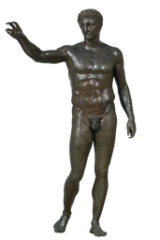
|
Antikythera bronze youth holding something, ca. 350 B.C. * possibly originally Greece |
|
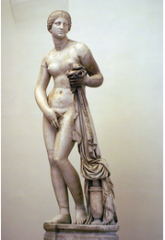
|
Aphrodite of Knidos * This is a copy made from descriptions, don’t know what it actually looked like |
|
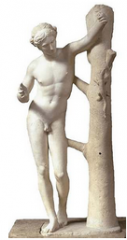
|
Apollo lizard slayer * 340 B.C. |
|
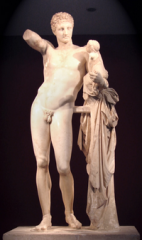
|
Hermes and Dionysus at Olympia (Hera temple) * Head tilt to make the S curve |
|
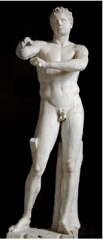
|
Athlete scraping himself * First most famous statue |
|

|
Hercules resting from labors (apples) * holding apples behind |
|

|
Alexander the Great statue type * flow= anistole |
|
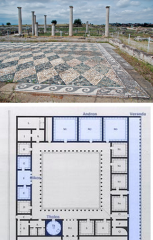
|
Vergina palace * circa 480 B.C. |
|

|
Vergina tomb: rape of Persephone painting * 1st tomb they found that was plundered |
|
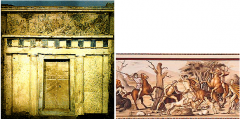
|
Vergina “Philip II” tomb: gold coffin, diadem, ivory figurines, hunt painting · Looks like temple with columns · Temple must have been painted; Triglyphs painted blue · Nicest architecturally speaking tomb; 2 chambers, was completely sealed when first discovered · woman inside marble sarcophagus and inside gold box. About 25 year-old woman. her cremated remains were in the gold box and bones wrapped in fine gold threads in box. · Adjustable gold diadem symbol of royalness · Small ivory head, “alexander” suggesting this is royal, but not totally certain this is royal burial · painting on the outside gives scene of hunting. Purple reserved for royals. Youthful in center of scene. Hunt scenes very prominent in Macedonian things |
|
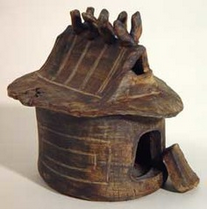
|
Villanovan hut burials * sometimes put in pots so that the ashes don’t fly away (covered by a helmet; if bronze that means it a burial place of a warrior) |
|
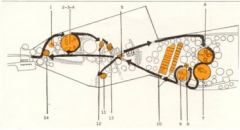
|
Cerveteri cemetery plan 7th and 6th BC give up much of their riches to tombs Rock-cut chambers, 3-7 in each of the shaded areas covered up by the tomboulis (mounds) Intricately cut rock to look like houses for the dead Mounds are huge and have little rock fences Inscriptions: they have first and last names, their last names are clan names. First name is your given name, then second name is clan name and these clan names encompass main nuclear families that belong to the clan Conspicuous consumption, elites showing off things like elaborate wagons and fibulas (safety-pins) |
|
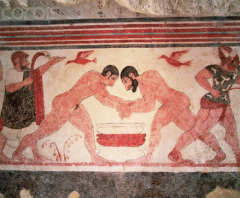
|
Tomb of Augurs, Tarquinia * painted tombs mean Tarquinia |
|

|
Tomb of Hunting and Fishing, Tarquinia * make the figures small compared to large natural environment nature → new aspect in painting portrayed here |
|
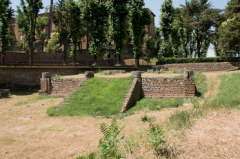
|
Etruscan temple, Orvieto * Etruscans were not borrowing temple designs, but borrow other things from greeks (lots of borrowing within societies) |
|
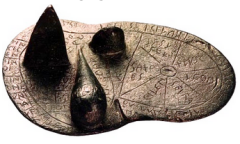
|
Etruscan liver model * Etruscans masters of divining future events from animal liver. Might reveal something of god’s will |
|
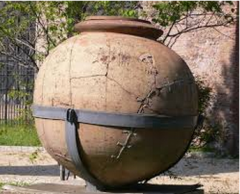
|
Archaic Rome, dolium burials * 8th c. B.C. |
|
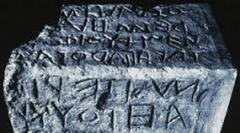
|
Archaic Rome: lapis niger a blue-gray limestone paving go underneath it and find alter from 4th century, and cippus: stone set upright with inscription. Writing in latin, mentions king with some religious duty he had to fulfill. So this means there was a king in rome in 6th century. Might be Etruscan king and confirm that the Etruscan king is true |
|
|
Archaic Rome: regia building (royal) |
* Growing body of evidence that there was a king and that his duties were mostly religious. Headquarters where Etruscan presence was with scenes sculpted in wall |
|
|
Archaic Rome: Capitoline temple |
Built temple on big hill called Capitoline hill. Temple built as celebration of independence |
|
|
Pompeii history (riot in amphitheater 59 A.D., earthquake 62 A.D., Vesuvius 24 and 25 August 79 A.D.) |
* Have dated literary sources which is why we know the dates
|
|

|
Vesuvius eruption (Plinean phase and pyroclastic flow and date) * pyroclastic flow, seen by young Pliny from naval base, sees a flash and a fast moving cloud that leaves the volcano. this phase will make a person’s brain melt in about 4 seconds. hits you almost like a nuclear blast. it’s like a sweep of gas |
|
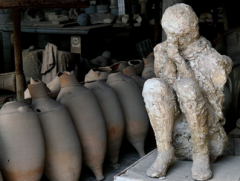
|
Bodies (plaster casts, the “thinker” and skeletons from Herculaneum sea shore) * 79 A.D. |
|
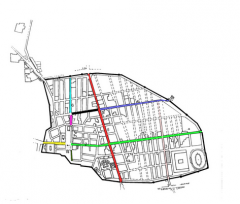
|
Pompeii: town plan, castellum aquae, and fountains * Neighborhood identity that first comes out through water, so design for neighborhood |
|

|
Pompeii: brothel * Hundreds of inscriptions in waiting room area in greek, latin, and oscan, and not single one can be identified with elites |
|
|
Pompeii: Forum and Building of Eumachia |
* inscription is found on statue of a woman
|
|
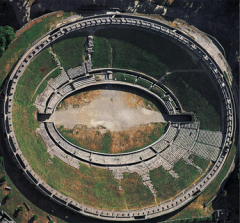
|
Pompeii: Amphitheater and Valgus and Porcius, ca. 80 B.C. · 2 men elected like mayors (duovirs) that run Pompeii initially have to have certain criteria but have to be elected by people · graffiti like “the bakers want you to vote for blah for duovir”. Leave on walls for years. · Rich people upper class who are elected. To thank the people they build something. · Valgus and porcius, duovirs built amphitheater and inscribed it for spectacles. Establishes relationship between people of Pompeii and rich people. Then the people say thanks for amphitheater, here’s a statue of you looking heroic on a horse put up in the forum. Back and forth relationship between people and duovirs, dedicating things to each other |
|
|
Painting styles: 1, 2, and 3 (with dates) |
All 200 to 80 BC (probably does not want a range) style number 1: Large blocks of color, Throughout Greece style number 2: Along with blocks building off and making 3d, With curves and windows, Included windows and architecture style number 3: Making less 3d and making it more one dimensions, Still included windows and architecture |
|
|
Pompeii houses: vestibule, atrium, tablinum, and peristyle axis |
vestibule makes first impression → mosaic flooring, little guard dog (beware of doggy) · atrium: hole in ceiling where water spilled through like a little water fall; large roof spans, idea of open big public place. Atrium walls highly decorated · columns framing office space (tablinum) where business deals went down; goes into peristyle. sometimes cases to display household gods · its more and more elite access as you go deeper into the house · lines of sight orderly and precise · if you want to emphasize how rich you are, have lock boxes to hold your money. Can put 2 chests in atrium. (Atrium impluvium) · can also put images of ancestors in atrium |
|

|
House of the Faun and Alexander Mosaic * biggest mosaic floor of alexander in battle. Possibly made with over 2 million stones |
|
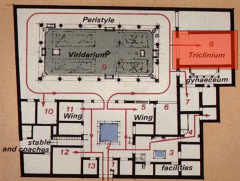
|
House of the Vettii: plan, Priapus, peristyle, and triclinium · Vestibule (make first impression) to atrium and no tablinum · Painting of guy weighing his dick against bag of money. Roman god, stands for fertility. So this painting says we have a lot to eat (fruit basket), lot of kids, and lot of money. Fertile, happy household; Sculpture with theme of plenty as well. · Lock boxes to show lots of money too. Emphasis on money · Tablinum missing, means they’re doing business in peristyle. · triclinium room 8- dining room signs of kitchen there was a bread oven · peristyle: stop look at individual pictures · picture gallery, while dining discussing greek philosophy |
|
|
Pubilus Vesonius Phileros (freedman) |
· Was a slave and made free · Made for himself, his friend, and his patron’s daughter · Patron-client relationships; Social responsibility to put up tomb of daughter of his patron. · Inscription seems hateful at first, but it’s a joke because if he really hated his friend he would have taken out sculpture or crossed out his name or something · Signifies playful bantering with romans |

